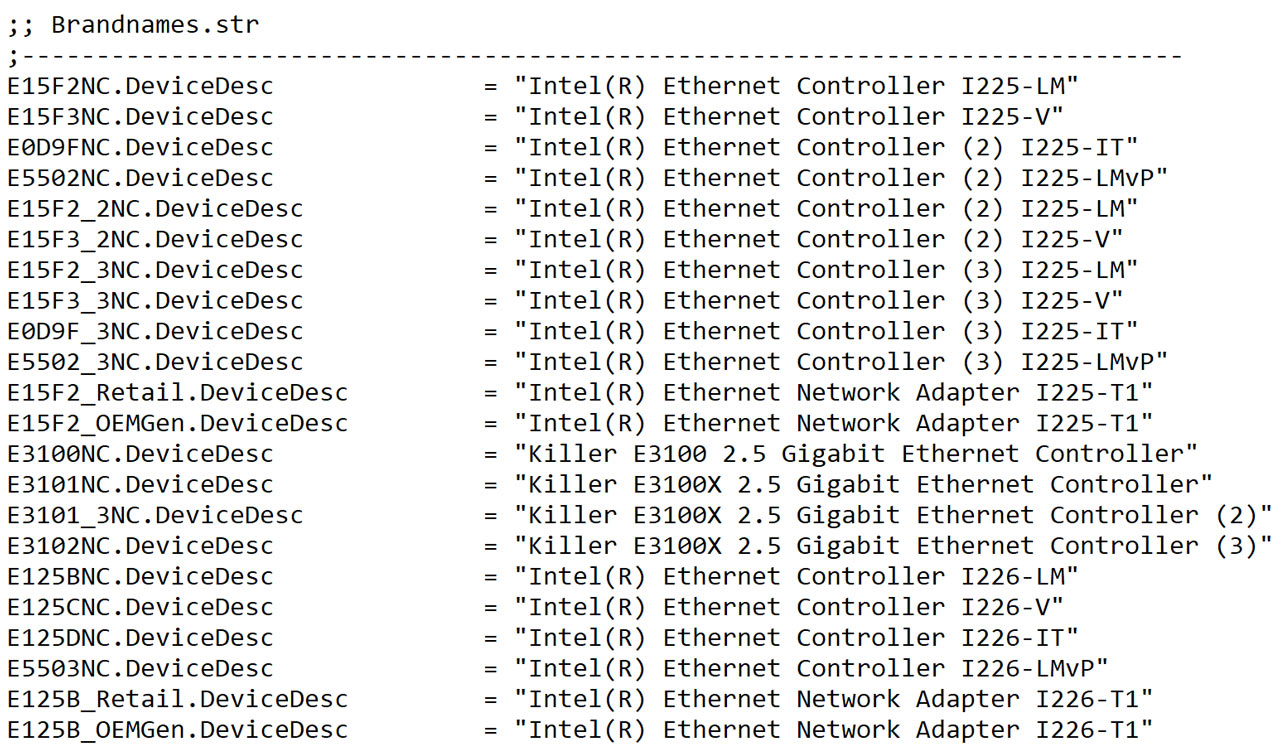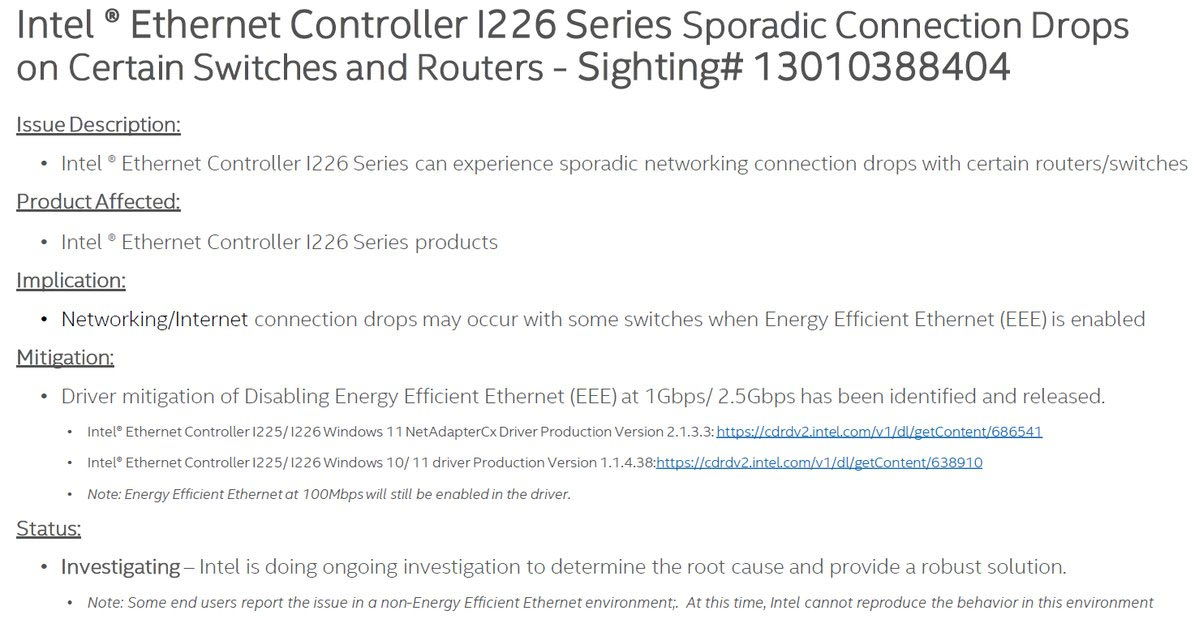Intel Patches Stuttering Ethernet Issues, but It's Just a Workaround for Now
MSI has made the update available for its I226/I225 and Killer E3100 2.5GbE motherboard users.
Intel is still working on a comprehensive fix for the intermittent Ethernet connection issues we highlighted in a report back in January. In the meantime, it has a workaround that basically turns off Energy Efficient Ethernet (EEE) mode. MSI appears to be the first Intel partner to release an installer delivering the workaround. Intel says it is continuing to “work towards a solution.”
If you have a modern Intel motherboard featuring a version of the Intel I225, I226, or Killer E3100 2.5GbE controllers, the headlining update is for you. Users with motherboards packing these controllers have reported intermittent disconnections when using Ethernet. Thus, you will not have observed this particular issue if you only use Wi-Fi for your internet and LAN connectivity.
Intel Raptor Lake motherboards often leverage the new Intel I226-V controller, so this intermittent connection issue (which similarly annoyed users of the previous-gen motherboards/controllers like 2019’s I225) continues to provide disappointment to the newest-gen customers.
Previous advice regarding workarounds, such as reducing the controller’s max transfer rate to 1 Gigabit, were not bulletproof when we last reported on this Ethernet issue. However, Intel appears to have narrowed down the cause of the connectivity dropouts to some kind of energy-saving functionality present in the driver. Unfortunately, it wouldn’t be the first time that energy efficiency implementations end up causing users to spend a lot of their personal energy in fault-finding and fixing productivity sapping side effects.
Intel’s update, shared by Chi11eddog, says it includes the mitigation of “disabling Energy Efficient Ethernet (EEE) at 1Gbps / 2.5 Gbps.” It is possible to do this tweak yourself in Advanced Windows/ Linux driver settings, but the downloaded patch may have a little more finesse, as it seems to still apply EEE at 100Mbps speeds.
MSI has released an updated driver for its affected motherboards, like the MPG Z790 Carbon WIFI. We have looked at the download file, which doesn’t include release notes, and are not sure whether the files within will work on motherboards/systems from other brands. We think that others could right click and install the E2FN.INF file, but please apply at your own risk. Please note there are different drivers depending on whether you are using Windows 10 or 11. Also, you should check your own motherboard vendor’s update pages to see if there are Intel Ethernet patch / update files available for your specific product.
We hope that Intel’s investigations reveal that this continuing problem for its networking controllers is fixable by software or firmware update, rather than leaving users with energy saving functionality disabled or a hardware revision being required.
Get Tom's Hardware's best news and in-depth reviews, straight to your inbox.

Mark Tyson is a news editor at Tom's Hardware. He enjoys covering the full breadth of PC tech; from business and semiconductor design to products approaching the edge of reason.
-
mac_angel Has Intel released a set of drivers themselves? Or did MSI adjust the drivers themselves?Reply -
in_the_loop Strange.Reply
I have an MSI Pro 'Z690-A motherboard (Non WIFI) which DO have the I225-V 2.5 GB LAN that is in the list.
I only use LAN for everything and haven't noticed any disconnections. 500 megabit down and up for Internet working at full speed. Internal network seems to work correctly too. -
FoulFoot I don't know that we need energy-saving enhancements on the ethernet controller, for chrissakes. Saving what, a thousandth of a watt?Reply -
MASOUTH This whole issue is so weird. It's like there was a meeting at Intel...Reply
"We've long been the reliability benchmark of PC NIC's to such an extreme that some customers will not even consider the competitors no matter how much they have improved. Let's see if we can fix those perceptions...." -
bit_user Reply
No, it's 1.3 - 1.5 W:FoulFoot said:I don't know that we need energy-saving enhancements on the ethernet controller, for chrissakes. Saving what, a thousandth of a watt?
https://ark.intel.com/content/www/us/en/ark/products/series/210588/intel-ethernet-controller-i226-series.html
For the I225-V, it's nealy 2 W:
https://www.intel.com/content/www/us/en/products/sku/184676/intel-ethernet-controller-i225v/specifications.html
You might think that's no big deal, but if every chip & port in a PC had no power-saving mode, the PC's idle power would increase quite a lot. Given most PCs (especially in a corporate setting) spend most of their time near idle, there might be some big corporate customers who care about such things. Commercial electricity rates are usually a multiple of residential, and you have to pay extra to remove the heat during the summer.
My employer tracks energy usage, and has annual targets for reductions. -
2Be_or_Not2Be I am just disappointed that this issue has persisted into the I226. I had this issue w/my I225 on my home PC, and I basically disabled all power-saving on it. How they can produce new silicon & still have the same problem, is just sad.Reply
Now, speaking of their rep, all of my servers used to be only Intel NICs, dual or quads. They were the standard, after the departure of 3Com. I guess I can make do w/adjustments in my home PC, but I would not tolerate it in a server. -
bit_user Reply
I remember paying a couple hundred bucks for a 3Com PCI 100 Mbps NIC, back in the late 90's.2Be_or_Not2Be said:They were the standard, after the departure of 3Com. -
blppt "They were the standard, after the departure of 3Com."Reply
Its a strange world we live in---where people say "I have a Realtek NIC" with pride. -
Kamen Rider Blade How has Intel NIC(s), who use to be the "Gold Standard" of Networking fall so far?Reply
Does anybody have a history lesson on when their troubles began?
Is this worth a long term article?
How has RealTek rised in it's place?

